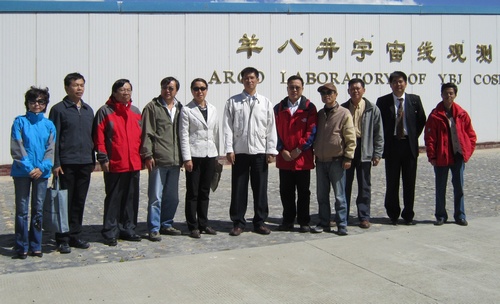CAS and Tibet join hands in pushing forward the construction of science infrastructure
A CAS delegation led by Prof. ZHAN Wenlong, Vice President of the Chinese Academy of Sciences (CAS) visited the Tibet Autonomous Region from August 28 to 29, 2011.
 |
| Prof. ZHAN and his delegation in Tibet |
Mr. DING Yexian, Vice-Chairman of the Autonomous Region People's Government, welcomed Prof. Zhan and introduced the grand ceremony marking the 60th Anniversary of Tibet's Peaceful Liberation in Lhasa and the earthshaking changes taking place in Tibet over the past 60 years.
Prof. ZHAN was deeply impressed by the rapid development in Tibet and expressed that CAS would continue to make contributions to the future prosperity and development of Tibet. He then introduced that during the Twelfth Five-Year plan, 16 national key scientific facilities will be constructed in China, including the Large High Altitude Air Shower Observatory (LHAASO) Project in Tibet. In his speech, ZHAN also mentioned the research activities in Tibet conducted by the National Astronomical Observatories (NAOC), and the cooperative R&D efforts made by the Qinghai Institute of Salt Lakes (ISL) and Tibetan Mining Department.
Mr. DING spoke highly of the cooperation between CAS and the Autonomous Region People's Government. Both sides reached an agreement in co-conducting the LHAASO project during the Twelfth Five-Year plan.
On August 29, Prof. ZHAN made an inspection tour on Yangbajing (YBJ) Cosmic Ray Observatory, where he listened to presentations on the on-going activities in the observatory. While he visited the Tibet ASγ Experiment (Sino-Japanese Cooperation) and the ARGO -YBJ Project (Sino-Italian Cooperation), ZHAN witnessed the arrays of the four LHAASO detector prototypes and expressed his satisfaction with the progress achieved so far. Prof. CAO Zhen from the Institute of High Energy Physics reported the LHAASO Project and its significance. He said that the LHAASO detector arrays would require an open space of about one square kilometer; the local government had agreed to set up a joint team with IHEP to make site selection.
It is hoped that based upon great advantages in its geography, climate and environment resources in Tibet, first-class research projects will be done.